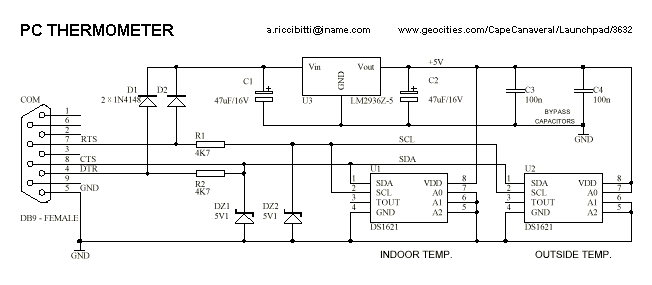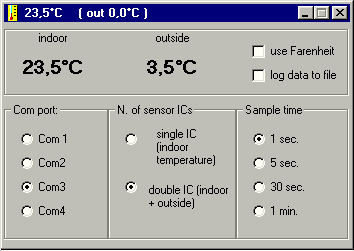DS1621 pc thermometer
So cool you can even measure it!
This incredibly simple thermometer plugs on any free serial port. Does not make use of any programmable components as microcontrollers. It gives temperature readings accurate to 0.5В°C with no calibration. It's cheap, so I've put one on any PC I use. And it is so nice to have the temperature shown on the Windows taskbar, that a million friends asked me to build one!
Build yourself an accurate thermometer
Since I have no time to build a million pcTHERMs, I give you the plans and
the software to build one on your own.
This project is easy enough for beginners, the only difficulties possibly
arising from serial port hardware incompatibility from PC to PC. In the
single-sensor version, you need only the sensor IC, a voltage regulator and and
handful of diodes and resistors. Build it, and learn the secrets of IIC bus, how
to implement IIC bus using only two resistors and a couple of zeners, how to
drive it on a serial port using Visual Basic .Components involved are
available on the worldwide RS-components catalogue.
Tech facts:
|
Circuit diagram
 |
Parts list
2 x 1N4148 diodes
2 x 5.1 volt 1/4W zeners
2 x 4700 ohm resistors
2 x 100 nFcapacitors
2 x 47uF 16V el.capacitors
2 x DS1621 digital temperature sensors (Dallas Semiconductor)
1 x LM2936-z5 low-droput 5V regulator(National Semiconductor)
1 x DB9 female plug.
How it works
The circuit is derived from the Claudio Lanconelli's PONYPROG programmer (I recommend you to visit the Claudio Homepage at http://www.cs.unibo.it/~lanconel ). The key component is the Dallas Semiconductor's DS1621 temperature sensor. This tiny 8 pin IC needs only +5 volts to measure the temperature and to send it out via its IIC bus output. Since many IIC bus devices can be connected in parallel, three address inputs (A0, A1, A2) are provided to select one out 8 addresses the device will respond on. This way, up to 8 sensors can be connected in parallel. I have set the internal temperature sensor to address 0 and the external one to address 1. If you plan to use only one sensor connect it as address 0.
Interfacing the IIC bus to the RS232 com port is a matter of adapting levels.
IIC works on 0..5V signals, RS232 uses -12V .. +12V. The trick here is that,
altough specified for -12V..+12V, almost all PC com port I know work equally
well with 0..5V signals. This eliminates the need to raise the IIC output to
RS232 levels, and the SDA data line connects directly to the PC CTS line. On the
opposite way, the RS232 signals can damage the IIC inputs, so I placed voltage
limiters (R1, DZ2, R2, DZ1) on the SCL clock input and SDA data input. (note
that SDA is bidirectional: receives from the DTR line and transmits to the CTS
line).
Since the circuit draws very little current, there is no need to add an external
power supply. The +12V from the RS232 lines are conveyed to the regulator by
diodes D1, D2, filtered by C1 and regulated to +5V by the LM2936-Z5. Don't
replace it with an ordinary 78L05 regulator unless you want to add an external
9V battery: the LM2936 is capable to regulate even with input voltages near to
6V, as is the case of many serial ports.

the pcTherm window expanded
The software
I wrote the software in Visual Basic 5 (Yes, no assembler or C++ this time!).
I've done it the straight way, with no optimizations that would make it less
readable. Even with this limitations, the IIC runs at a respectable 1,5 kHz even
on a slow P90 in interpreted mode. The very first time you run the program, you
will be warned that the setup file does not exists (it will be automatically
created at the end of the session) and defaults will be used. When you start the
program, it runs minimized on the taskbar, providing a "temperature icon". This
is my preferred way to use it, just like the "clock" icon provided with Windows.
Clicking on the icon opens up the setup window, allowing you to select one of 4
com port, the number of sensors attached, the interval between successive
measurements, the measuring unit and if you want to log temeperatures on the
file "pc_therm.txt". If you select the wrong port, you can get both false
measurements or a "unable do read" messages.
Files available:
Visual Basic Sources (VB5, 6kB) for those who have VB installed
Executables, reduced size (13 kB) pc_thermometer.exe only, does not include the VB runtime and system DDL's, copy to a folder and run pc_thermometer.exe. Works on many machines with others VB5 programs installed
Executables, full size (1,5 MB) includes setup.exe utility and everything but the sources
Be sure to check the FAQ page for further information about the thermometer.
Title: DS1621 pc thermometer
electronic circuit
Source: ://www.riccibitti.com
Published on: 2005-02-03
Reads: 1085
Print version: ![]()
Other electronic circuits and schematics from PC related
-
Use the CD-ROM drive as a audio CD player without the computer
-
Parallel Port Relay Interface
-
RJ45 Network card to IR communication
-
Stepper motor controller
-
RS-232 Laser Transceiver
-
Simple PC thermometer
-
Improved Infrared Receiver with status led
-
Monitor Your PC's CPU Core Temperature
-
3-Axis Stepper Controller
-
LCD2LPT with LIRC
